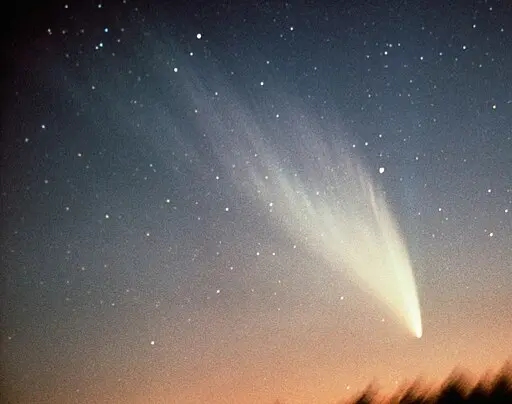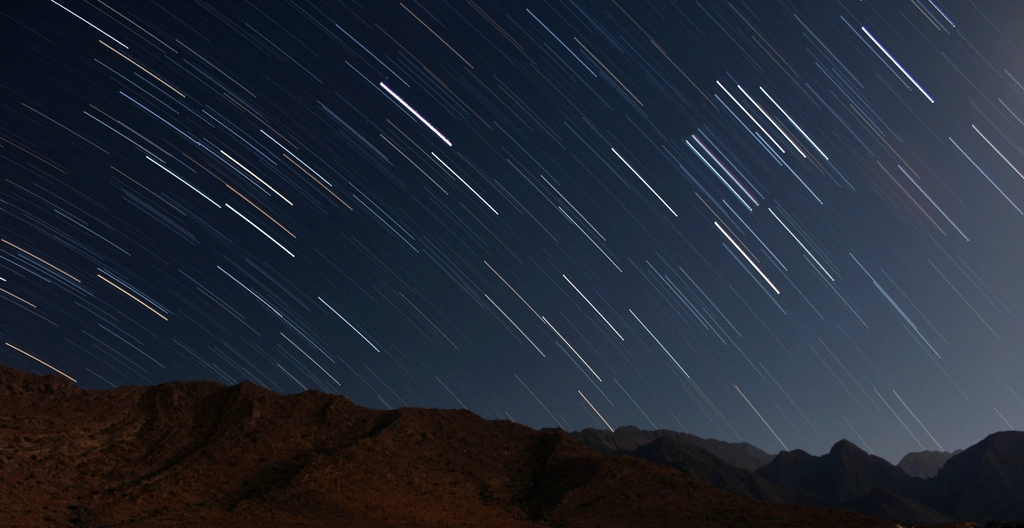At my very first astronomy club meeting, I expected some small talk and maybe a few star charts—but I didn’t expect a full-on meteor crash course! Our club president gave a talk called Meteors 101, and it was the perfect intro to shooting stars, space rocks, and the best nights to watch the sky.
Presentation Recap: Meteors 101 with Paul
Paul’s talk covered all the basics, from what meteors are to the best times to catch them. The presentation was packed with useful info, fun facts, and some surprising science (spoiler: Hollywood lied to you). Here’s a quick recap.
What Exactly Are Meteors (and What They’re Not)
We often call them “shooting stars” or “falling stars,” but meteors have nothing to do with stars—aside from dazzling us from the same sky.
In fact, early astronomers didn’t know that. Paul told an adorable story about how ancient sky-watchers, responsible for tracking the stars’ positions, were horrified when they witnessed their first meteor shower. Thinking actual stars were falling from the sky, they panicked—convinced they would all be out of a job by morning.
Meteors are actually tiny particles of space debris—usually rock or metal—that enter Earth’s atmosphere at incredible speeds (7 to 44 miles per second).
As they hit the atmosphere, they blaze brightly and briefly thanks to a process called ram pressure—the intense friction from colliding with atmospheric gases makes them heat up and glow.
In other words, the particle is hurling through space freely until it “rams” into the dense mass of our atmosphere, causing the spark we all recognize as a shooting star.
Most meteors are no larger than a grain of sand, and they usually burn out high above us in less than a second. If the particle survives the journey and hits the ground, it becomes a meteorite. And before it enters the atmosphere? It’s called a meteoroid.
If none of that sounds right to you, blame the movies. Paul made a big point that they literally always get it wrong. Honestly, Hollywood. It’s just irresponsible.
Now that we know what meteors are, where do they come from?
Meteor origins:
- 90–95% come from comet debris
- 5–10% come from asteroids
Paul likened asteroids to leftover construction materials—solid chunks of rock and metal debris from the days of our solar system’s formation.
Comets, on the other hand, are better described as “dirty snowballs”—frozen mixes of particles, ice, and dust.
People often confuse comets and meteors. In reality, comets dwell in deep space, while meteors are much closer—flashing through our atmosphere. According to Paul, people often think it’s the reverse.
We also talked about a few different kinds of meteors:
- Fireballs: Bright meteors (like the one I saw at my April 3 neighborhood outreach—turns out April is a good month for these!)
- Bolides: Larger fireballs with explosive brightness
- Earthgrazers: Rare meteors that skim across the atmosphere at a shallow angle, similar to a rock skipping across a pond
What Are the “Meteor Doldrums”?
The meteor doldrums are quiet stretches between major showers—lower activity, fewer visible meteors. One such lull lasts from mid-January to mid-April, after the Quadrantids and before the Lyrids. There are minor showers during this time, but nothing like the Top 10. Thankfully, we’re just now emerging from this one!
How Often Do Meteors Happen (and Where Should You Look)?
Meteors happen constantly. Earth collects roughly 48.5 tons of meteor dust per day. Think about that next time you’re dusting your house.
Most of these ongoing meteors are faint and unnoticeable, but the brightest ones can occasionally be seen in daylight.
Sporadic meteors are random meteors seen between showers, at an average of ~7/hour.
The best time to see more meteors is after midnight, due to the radiant effect (described below).
Meteor Showers & the Radiant Effect (a.k.a. That Windshield Analogy)
Meteor showers occur when Earth moves through a comet’s debris trail. The radiant is the specific point in the sky from which meteors in a given shower appear to originate. It’s a visual illusion, kind of like train tracks seeming to converge in the distance.
Every meteor shower has its own radiant, usually named after the constellation it’s in (e.g., the Perseids appear to radiate from Perseus). The higher the radiant is in the sky, the more meteors you’ll likely see.
So what’s the radiant effect?
It’s the reason more meteors show up after midnight. After midnight, your part of the world rotates to face the direction Earth is traveling through space.
That shift means you’re now on the “front-facing” side of Earth—essentially plowing into the stream of debris.
Paul compared it to driving through rain: the windshield (the side facing forward) collects more raindrops than the back window. Same idea with meteors.
Higher radiant + forward-facing Earth = more meteors = more FUN!
Top 10 Meteor Showers of the Year
Here’s a handy table of the most reliable and popular meteor showers, along with their typical active dates and peak nights. Mark your calendars!
| Shower Name | Dates | Maximum |
|---|---|---|
| Quadrantids | 28 Dec – 12 Jan | 3 January |
| April Lyrids | 16 – 25 April | 22 April |
| Eta Aquariids | 19 Apr – 28 May | 6 May |
| Delta Aquariids | 12 Jul – 23 Aug | 30 July |
| Perseids | 15 Jul – 24 Aug | 12 August |
| Orionids | 2 Oct – 7 Nov | 21 October |
| Taurids | 15 Sep – 15 Dec | 7 November |
| Leonids | 6 – 30 Nov | 17 November |
| Geminids | 4 – 17 Dec | 13 December |
| Ursids | 17 – 26 Dec | 22 December |
🌠 Meteor Shower Extras: Cool Stuff You Might Not Know
- The Leonids follow a 33-year cycle, tied to the orbit of their parent comet (Tempel–Tuttle). When the comet swings closer to Earth, the shower can jump from a quiet flicker to a full-blown meteor storm.
- Halley’s Comet is the parent of two major showers: the Eta Aquariids in May and the Orionids in October. Earth intersects its debris trail twice—once as the comet heads into its orbit, and once on the way out of orbit.
- Up to a dozen meteor showers can happen at once—each with its own radiant point and speed.
Meteor Watching: The Basics
- No telescope needed—just your eyes
- Binoculars can enhance viewing
- Dark skies + comfy recliner = best combo
- Avoid city lights and obstructions
- Focused observation is better than distraction
- Watch during Top Ten showers for best chances
- Avoid Full Moons, aim for New Moon
Bonus Fun Facts from the Meeting
☄️ A Rare Meteorite Landing in Florida?
Fun fact: Florida is a particularly narrow target, so it’s pretty rare for meteorites to land here. They usually land to the east or west of us, in the gulf or the ocean. But at some point (I failed to catch when), a meteor directly exploded over Ocala, FL, right in the middle of the state, leaving a collection of fragments behind.
☄️ The Comet That Got Ghosted… Then Showed Off
In the 1970s, Comet Kohoutek was hyped to be a major celestial event. It fizzled—hard. The media got burned and stayed silent the next year when Comet West approached.
But Comet West delivered! It appeared in the morning sky with a fan-shaped tail rising first, followed by the glowing head. Someone pulled up a photo during the meeting and indeed it was stunning.

According to speaker and club president Paul, the hype around Comet Kohoutek helped spark the formation of the club itself. Good thing they were in place for Comet West’s spectacular arrival a year later!
Can’t wait to catch my next fireball—this time, I’ll actually know what I’m seeing.

